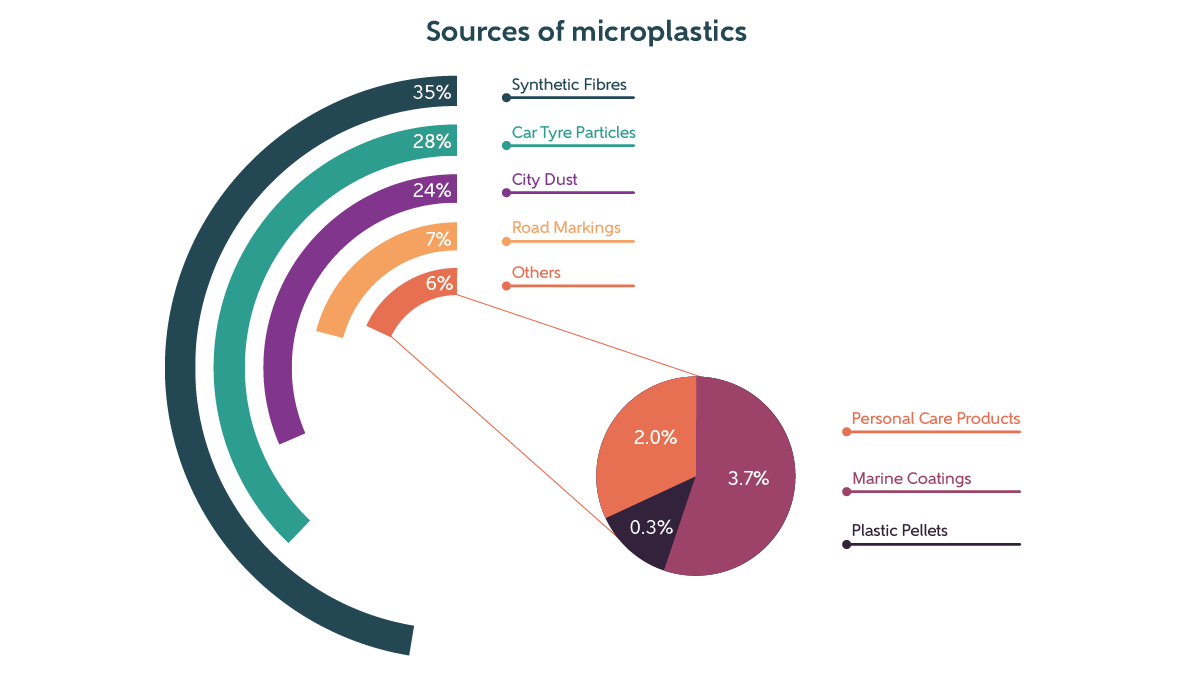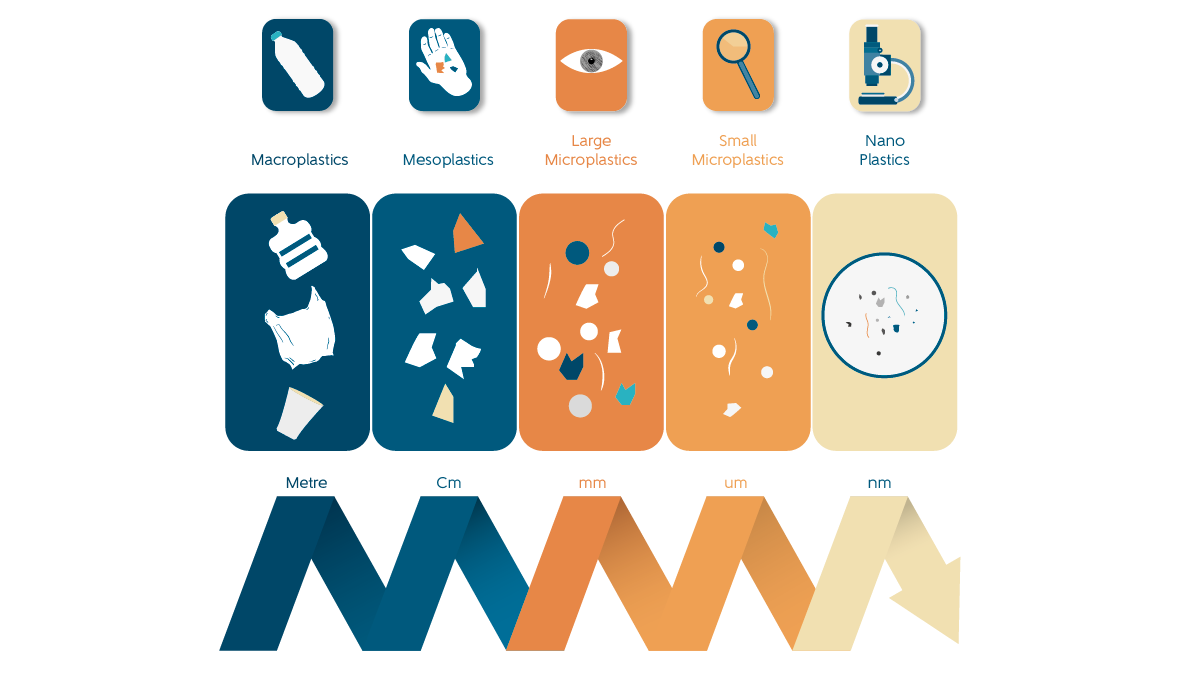A new study commissioned by Seas At Risk and carried out by the Galway-Mayo Institute of Technology shows that microplastics in the marine environment come from numerous sources and economic sectors, and have widespread environmental impacts, including climate implications. Moreover, the study also offers effective solutions that can limit the impacts of microplastics by preventing their release at source.
—
“Given the expected exponential increase of global plastic production, and the subsequent release of microplastics into the environment, it is vital to urgently prevent this pollution from escalating, and to avoid dramatic consequences on marine biodiversity, global ecosystems and the climate”, says Frédérique Mongodin, Senior Marine Litter policy officer with Seas At Risk. “As certain types of plastics release more microplastics, toxic chemicals and GHGs than others, choosing the right type of plastic and additives in the design phase can drastically reduce microplastic pollution. However, only the adoption of mandatory and targeted upstream measures at EU level will enable the necessary adjustments across sectors”.
Sources of Microplastics in the Marine Environment
The widely discredited, personal care products that contain intentionally added microplastics – such as glitter, or microbeads found in scrubs – only constitute the tip of the iceberg, representing a mere 2% of the total microplastics released into the marine environment.
In fact, the majority of microplastics in the ocean are unintentionally released microplastics, and come from sources such as tyre dust, synthetic textile fibres, city dust and marine paints.
You might also like: Seas At Risk: How to Shape a Future Without Mining

Moreover, additional microplastics resulting from the degradation of larger plastic items at sea come from most economic sectors, including agriculture, construction, tourism, aquaculture, fisheries and shipping. Of all plastic entering the ocean, 94% ends up on the seabed, where it will take centuries to degrade, releasing chemicals, microplastics and nanoplastics in the process which are all harmful for both marine life and ecosystem balance.
Impacts of Microplastics on the Climate
The GMIT study reveals that microplastics also have implications for the climate, both by contributing to the emission of GHGs that cause climate change as well as by reducing the mitigation effects of the ocean against climate change:
1) Emission of GHGs: Once exposed to solar radiation, certain types of plastics (mainly single-use plastics and packaging) undergo a gradual degradation and fragmentation process. This releases GHGs such as methane and ethylene. Methane contributes to greenhouse gas effects 34 times more than carbon dioxide and contributes directly to the exacerbation of climate change. With an expected increase of 33-36% in plastic production by 2025, emissions of methane are predicted to rise to 101-103 million tonnes if no mitigation efforts are implemented.
2) Reduced carbon sequestration: When plankton are contaminated by microplastics, they are less effective in ‘fixing’ carbon, and transferring it to the deep ocean. As a result, the carbon sequestration power of the ocean is reduced, decreasing its capacity to mitigate climate change. Data shows that 100% of plankton in EU estuaries are contaminated by microplastics.
Impacts of Microplastics on the Marine Environment
The most concerning environmental impacts of microplastics contribute to the loss of biodiversity, have implications on the marine food webs, and threaten ecosystem balance. In the study, GMIT researchers identified the following impacts:
1) Ingestion of microplastics by marine organisms: When microplastics are ingested by fish and other marine organisms, this can cause energy depletion, fertility and behavioural problems, harm, or in extreme cases, death. Around 50% of fish in the Mediterranean Sea and 80% of fish larvae in EU estuaries have ingested microplastics.
2) Bio-accumulation of hazardous substances by marine fauna and flora: Dangerous substances that are present in, or absorbed by microplastics can have serious consequences for marine flora and fauna. For example, in the US, run-offs from road dust including tyre wear caused mass mortality of fish in nearby rivers.
3) Dissemination of invasive species and pathogens: Microplastics can act as a vector for invasive species, bacteria and viruses, allowing them to be transported across long distances.
Solutions
Depending on their characteristics, certain types of plastics release a much higher quantity of microplastics, toxic chemicals or GHG emissions compared to others. Therefore, the solutions proposed in the study aim to prevent microplastic release at source:
1) Ban specific types of plastics that are proven to release a high number of microplastics, such as synthetic foam polymers (e.g. polystyrene packaging and boxes) and plastic mulch in agriculture and horticulture.
2) Set mandatory ecodesign requirements for textiles at the design stage to gradually eliminate most problematic fabrics and additives.
3) Establish a maximum threshold for microplastic release by tyres into the environment.
4) Mandate the containment of plastic production and recycling facilities to prevent the release of pellets.
5) Phase out potentially toxic additives and create an open access database of plastic additives to provide information on the presence of chemicals in products.
6) Mandate best practice handling rules and regular staff training to prevent the loss of maritime containers and fishing gear at sea as this generates large quantities of secondary microplastics.
7) Ban all non-essential single-use plastic products to reduce microplastic pollution in the long term.
8) Implement producer responsibility schemes to incentivise producers to develop more sustainable products and manufacturing processes.
Policy Context and Next Steps
In 2016 the European Commission launched a Plastic Strategy revealing its intention to tackle the problem of plastic pollution.
After the adoption of the Single Use Plastic Directive, which is currently being transposed into national legislation, the European Commission started looking into the problem of microplastic pollutants within the new zero pollution initiative of the European Green Deal. The Commission recently released the Zero Pollution action plan, which is the strategy for the years ahead and on which Seas At Risk commented.
Intentionally added microplastics are currently being tackled by the Commission, which is preparing a restriction based on a proposal from the European Chemicals Agency (ECHA).
The European Commission is currently analysing the unintentional release of pellets, microfibres and tyre wear into the environment, with the objective of evaluating the possible adoption of EU measures to reduce the scale of the problem.
From May 31 to June 4, the European Commission is organising the EU Green Week 2021 focused on Zero Pollution, where microplastics pollution is one of the topics being discussed.
Featured image by: Flickr
This article was originally published on Seas-At-Risk.org, and is republished here as part of an editorial partnership with Earth.Org.
About Seas At Risk
Seas At Risk is an association of environmental organisations from across Europe, working together to ensure that life in our seas and oceans is abundant, diverse, climate resilient, and not threatened by human activities. Its mission is to promote ambitious policies for marine protection at European and international level. With over 30 members representing the majority of European countries, Seas At Risk speaks for millions of citizens that care deeply about the health and well-being of seas and oceans.


















